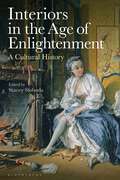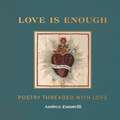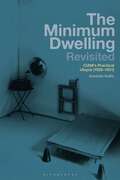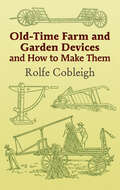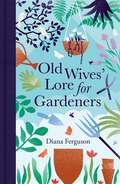- Table View
- List View
Interiors in the Age of Enlightenment: A Cultural History
Interiors in the Age of Enlightenment provides a comprehensive and interdisciplinary overview of the cultural history of interior design and interior spaces from 1700 to 1850.Considering the interior as material, social and cultural artefact, this volume moves beyond conventional descriptive accounts of changing styles and interior design fashions, to explore in depth the effect on the interior of the materials, processes, aesthetic philosophies and cultural attitudes of the age.From the Palace of Versailles to Virginia coffeehouses, and from Chinoiserie bathhouses to the trading exchanges of the West Indies, the chapters in this book examine a wide range of themes including technological advancements, public spaces, gender and sexuality, and global movements in interior designs and decorations. Drawing together contributions from leading scholars, this volume provides the most authoritative and comprehensive survey of the history of interiors and interior architecture in the long eighteenth century.
Landscape Appreciation: Theories since the Cultural Turn
by David JacquesExplanations for what makes one landscape scene preferred over another - formalistic, cultural and ecological - continue to be generated by landscape architects and land managers, philosophers and psychologists.This is needed for planning in the countryside and the protection of natural scenery, yet agreement still eludes us. This book does not favour any particular theory, but critiques the many theories seen over the last half-century. It informs readers of the main lines of argument so that they can make up their own minds. Part one, on post-war aesthetics, examines ideas about the unconscious, holism, overarching 'metanarratives', and the search for objectivity. Part two describes the consequences on the 'cultural turn' in that period, giving rise to new theories taking the human as reference. Cultural geography, cultural landscapes, changes in methods of assessment and some new ideas on landscape design are set in this context. Ecocentrism proposed a very different approach. The final part looks into the philosophical input, expanding upon 'environmental aesthetics'. It concludes with a more down-to-earth analysis of 'satisfactions' from immediate formal qualities, the sublime, meanings, and beauty. The balanced, didactic approach taken will make this a standard text for all those in teaching and in landscape practice.
Lit match and box of matches (Large Print)
This image shows a match that has been lit and a box with matches in it. There is a locator dot shown, which will be at the top left of the page when the image is the correct way up. The lit match is at the top of the page. The box with matches is at the bottom of the page. The match heads are on the right in the box. Only the top of the matches can be found. Test your tactile skills: - Can you find the flame of the lit match - How many matches are there in the box?
Lit match and box of matches (UEB Contracted)
This image shows a match that has been lit and a box with matches in it. There is a locator dot shown, which will be at the top left of the page when the image is the correct way up. The lit match is at the top of the page. The box with matches is at the bottom of the page. The match heads are on the right in the box. Only the top of the matches can be found. Test your tactile skills: - Can you find the flame of the lit match - How many matches are there in the box?
Lit match and box of matches (UEB Uncontracted)
This image shows a match that has been lit and a box with matches in it. There is a locator dot shown, which will be at the top left of the page when the image is the correct way up. The lit match is at the top of the page. The box with matches is at the bottom of the page. The match heads are on the right in the box. Only the top of the matches can be found. Test your tactile skills: - Can you find the flame of the lit match - How many matches are there in the box?
Log Cabin (Large Print)
This image shows a gable wall view of a cabin constructed from logs. There is a locator dot shown which will be at the top left of the page when the image is the right way up. The pointed roof fills the top half of the page. The rounded ends of the supporting logs are shown down from the two sloping surfaces of the roof. On the right side of the image there is a crooked chimney sticking out from the roof. Down from the roof is the wall of the cabin. Here the rounded ends of the logs making up the side walls are shown at the left and right edges of the image, and these interleave with the slightly irregular length logs making up the wall shown. In the centre of this wall is a wooden door with a large door knob and ledges above and below it. At each side of the door there is a window with wooden ledges to top and bottom.
Log Cabin (UEB Contracted)
This image shows a gable wall view of a cabin constructed from logs. There is a locator dot shown which will be at the top left of the page when the image is the right way up. The pointed roof fills the top half of the page. The rounded ends of the supporting logs are shown down from the two sloping surfaces of the roof. On the right side of the image there is a crooked chimney sticking out from the roof. Down from the roof is the wall of the cabin. Here the rounded ends of the logs making up the side walls are shown at the left and right edges of the image, and these interleave with the slightly irregular length logs making up the wall shown. In the centre of this wall is a wooden door with a large door knob and ledges above and below it. At each side of the door there is a window with wooden ledges to top and bottom.
Log Cabin (UEB uncontracted)
This image shows a gable wall view of a cabin constructed from logs. There is a locator dot shown which will be at the top left of the page when the image is the right way up. The pointed roof fills the top half of the page. The rounded ends of the supporting logs are shown down from the two sloping surfaces of the roof. On the right side of the image there is a crooked chimney sticking out from the roof. Down from the roof is the wall of the cabin. Here the rounded ends of the logs making up the side walls are shown at the left and right edges of the image, and these interleave with the slightly irregular length logs making up the wall shown. In the centre of this wall is a wooden door with a large door knob and ledges above and below it. At each side of the door there is a window with wooden ledges to top and bottom.
Love is Enough: Poetry Threaded with Love (with a Foreword by Florence Welch)
by Andrea ZanatelliIn this truly beautiful book, Andrea Zanatelli combines his extraordinary artworks with a selection of classical love poetry by Anne Brontë, William Blake, Christina Rossetti, Emily Dickinson, Percy Shelley and many more.Drawing its inspiration from the past, Love is Enough references the decorative arts of a bygone era, and is a combination of romantic imagery, antique fabrics and allegorical illustrations, mixed with poems and mottos. Often mistaken for real embroidery pieces, the artworks are in fact very detailed and intricate digital collages, made to look and feel like handcrafted works.Zanatelli is strongly influenced by the Arts and Crafts movement and the Pre-Raphaelites as well as eighteenth-century collage artist and creator of the Flora Delanica, Mary Delany, among others. Recurring themes in his work are romantic love, magical symbols, Victorian era craftsmanship, historical nun’s work and relics. Details of paintings, ancient fabrics, antique jewellery and miniatures are also returning elements as they often become an integral part of the inspiration for the collages themselves.This stunning book is full of intricate detail and brimming with romance, so you can return to its pages again and again.
Male Lion (Large Print)
Here is a picture of a lion with his body shown from the side. There is a locator dot shown, which will be at the top left of the page when the image is the right way up. His head is at the left centre facing you, with two ears, two eyes, nose and mouth. The lion has a mane of thick long hair around his head. Lower down the page are the lion's two front legs, and to the right its back legs, all with long claws on the feet. At the right of the lion's body is its tail with a furry end.
Male Lion (UEB Contracted)
Here is a picture of a lion with his body shown from the side. There is a locator dot shown, which will be at the top left of the page when the image is the right way up. His head is at the left centre facing you, with two ears, two eyes, nose and mouth. The lion has a mane of thick long hair around his head. Lower down the page are the lion's two front legs, and to the right its back legs, all with long claws on the feet. At the right of the lion's body is its tail with a furry end.
Male Lion (UEB uncontracted)
Here is a picture of a lion with his body shown from the side. There is a locator dot shown, which will be at the top left of the page when the image is the right way up. His head is at the left centre facing you, with two ears, two eyes, nose and mouth. The lion has a mane of thick long hair around his head. Lower down the page are the lion's two front legs, and to the right its back legs, all with long claws on the feet. At the right of the lion's body is its tail with a furry end.
The Minimum Dwelling Revisited: CIAM's Practical Utopia (1928–31)
by Professor Aristotle KallisThis book provides an intellectual history of the modernist "minimum dwelling", exploring how early modernism saw mass housing as a primary vehicle for achieving the utopian transformation of society. It reappraises the often-overlooked 2nd and 3rd CIAM conferences (1929-31), addressing their engagement with the "minimum dwelling" and revealing them both as milestones in the organisation's annals and as seminal moments in the history of interwar modernism.In 1929, an eclectic international group of avant-garde modernist architects, including Ernst May, Mart Stam, Walter Gropius and Le Corbusier, met in Frankfurt for the second instalment of the CIAM conferences. They discussed a design programme for cost-effective, good-quality housing, seeking new approaches and processes to maximize quality and functionality while ensuring affordability for the wider population. In exploring the meaning and form of the 'minimum dwelling', they also re-defined dwelling as the hub of a new way of living, proposing a revolutionary multi-scalar approach to urban design based on the concept of the Existenzminimum ('optimally minimal housing').Despite the two conferences falling short of the organizer's expectations, and being overshadowed by later instalments, the participating architects sanctioned a semantic shift from minimum as bare necessity to a very different, aspirational, kind of minimalism – transforming the entire conversation on mass low-cost dwelling in design, social and ethical terms.Split into two parts, The Minimum Dwelling Revisited first takes a genealogical approach to explore the provenance of the concept of "minimum dwelling" prior to the 2nd and 3rd CIAM conferences, it then traces the proceedings of the two conferences themselves. Addressing the origins of the "minimum dwelling" concept but also its legacies, and serving as a corrective to the overemphasis on 4th CIAM conference and the Athens Charter, the book is essential reading for scholars researching urban design during the Interwar period.
Mushroom (Large Print)
This is an image of an open-cap mushroom in the middle of the page. The mushroom is the fruiting body of a type of fungus. There is a locator dot shown, which will be at the top left of the page when the image is the correct way up. The mushrooms cap is at the top of the image. It is a warm grey in colour. Down the page from the cap, are the mushrooms gills (lamellae), they are represented as lines radiating from the top of the stem (stipe), which is further down the page. The dark brown lamellae produce spores that will grow into new fungi. The stipe extends down the page and at its bottom it would connect to a network of fine root-like hairs through which the organism absorbs its nutrition. These hairs have not been shown on the diagram.
Mushroom (UEB Contracted)
This is an image of an open-cap mushroom in the middle of the page. The mushroom is the fruiting body of a type of fungus. There is a locator dot shown, which will be at the top left of the page when the image is the correct way up. The mushrooms cap is at the top of the image. It is a warm grey in colour. Down the page from the cap, are the mushrooms gills (lamellae), they are represented as lines radiating from the top of the stem (stipe), which is further down the page. The dark brown lamellae produce spores that will grow into new fungi. The stipe extends down the page and at its bottom it would connect to a network of fine root-like hairs through which the organism absorbs its nutrition. These hairs have not been shown on the diagram.
Mushroom (UEB Uncontracted)
This is an image of an open-cap mushroom in the middle of the page. The mushroom is the fruiting body of a type of fungus. There is a locator dot shown, which will be at the top left of the page when the image is the correct way up. The mushrooms cap is at the top of the image. It is a warm grey in colour. Down the page from the cap, are the mushrooms gills (lamellae), they are represented as lines radiating from the top of the stem (stipe), which is further down the page. The dark brown lamellae produce spores that will grow into new fungi. The stipe extends down the page and at its bottom it would connect to a network of fine root-like hairs through which the organism absorbs its nutrition. These hairs have not been shown on the diagram.
Old-Time Farm and Garden Devices and How to Make Them
by Rolfe CobleighA splendid bit of rural Americana, Cobleigh's book shows how anyone with a little time and money can add a touch of authentic charm to their farm, house, or garden. First published nearly a century ago, this practical guide features dozens of projects, accompanied by some 200 illustrations. A simply written text not only tells how to mount an anvil, make a cheese press, and build hog houses, but also provides handy advice on splitting wood, testing seed corn, tying practical knots, sharpening scissors, and papering a room.From building a rose trellis to creating a bicycle-powered washing machine, readers will delight in this book’s abundance of enjoyable and useful projects. It’s perfect for novice craftworkers and die-hard fans of Yankee ingenuity.
Old Wives' Lore for Gardeners
by Diana FergusonPacked full of the age-old wisdom and expertise of generations of gardeners, who used their down-to-earth and practical experience to create beautiful, productive and useful gardens without spending a fortune.Behind every beautiful garden is the skill and experience of the gardener who tends it. How do you know which plants will thrive in your patch, given the bewildering array on offer? How do you know what soil and location they will like? And what do you do about all those pests just waiting to tuck in, not to mention the fungal diseases that suddenly turn your rose leaves from glossy green to blotchy yellow and coat other leaves with a powdery white dust? Just how do you tackle these gardening challenges, while being eco friendly at the same time? This is where Old Wives’ Lore for Gardeners comes in. Packed within its pages is all the age-old wisdom of generations of gardeners, people who knew a thing or two about plants. They lived before the days of chemical pesticides and concocted kitchen-cupboard remedies to treat pests and diseases. They gardened organically – although they wouldn’t have called it that – because there was no other choice on offer. With a wealth of savvy and cost-effective tips and advice, intriguing facts, snippets of history and quotes, Old Wives’ Lore for Gardeners is not only a fascinating read but also an invaluable guide to the gardening practices of old, which are as relevant today as they have ever been.
Planting Design: A New Naturalism (Workshops on Garden Design)
by Catherine Heatherington Juliet SargeantAimed at professional and novice garden and landscape designers; covers the background history and design consideration of naturalistic planting. Architecture (Landscape) & Town Planning; gardening
Romany caravan (Large Print)
This image shows the side view of a painted Romany caravan. There is a locator dot shown, which will be at the top left of the page when the image is the right way up. At the lower left of the image, four steps lead up to a door at the rear end of the caravan, which is not visible in this image. To the right of the steps at the bottom of the image, two of the caravan's four spoked wheels can be seen with the larger on the left. Above the small wheel on the right is the supporting frame upon which the axle turns. The axle cannot be shown. Above the wheels, decorative columns are shown on the panelling of the caravan, leading up to two windows with open shutters. The painted wooden roof sticks out beyond the body of the caravan at the top of the image, particularly at the back.
Romany caravan (UEB Contracted)
This image shows the side view of a painted Romany caravan. There is a locator dot shown, which will be at the top left of the page when the image is the right way up. At the lower left of the image, four steps lead up to a door at the rear end of the caravan, which is not visible in this image. To the right of the steps at the bottom of the image, two of the caravan's four spoked wheels can be seen with the larger on the left. Above the small wheel on the right is the supporting frame upon which the axle turns. The axle cannot be shown. Above the wheels, decorative columns are shown on the panelling of the caravan, leading up to two windows with open shutters. The painted wooden roof sticks out beyond the body of the caravan at the top of the image, particularly at the back.
Romany caravan (UEB uncontracted)
This image shows the side view of a painted Romany caravan. There is a locator dot shown, which will be at the top left of the page when the image is the right way up. At the lower left of the image, four steps lead up to a door at the rear end of the caravan, which is not visible in this image. To the right of the steps at the bottom of the image, two of the caravan's four spoked wheels can be seen with the larger on the left. Above the small wheel on the right is the supporting frame upon which the axle turns. The axle cannot be shown. Above the wheels, decorative columns are shown on the panelling of the caravan, leading up to two windows with open shutters. The painted wooden roof sticks out beyond the body of the caravan at the top of the image, particularly at the back.
